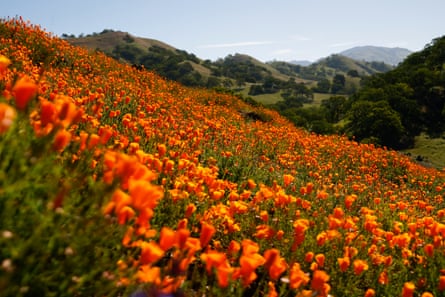For 41 years, the charming Theodore Payne Wild Flower Hotline has led people to California’s most bountiful blooms
For Californians, it is a rite of spring to seek the yearly wildflower blooms that erupt across arid shrublands, hillsides and desert landscapes in kaleidoscopic colour.
For the past 41 years, the Theodore Payne Wild Flower Hotline has helped guide their journeys. Wildflower seekers in southern California can dial (818) 768-1802, ext 7, for counsel on where to locate the best and most bountiful blooms in the region.
Call up in early March, and a mellifluous voice will offer that north of Los Angeles, warmer days are “slowly rousing spring wildflowers from their slumber”.
It is still early in the season. But in the Sierra woodlands: “The diminutive red maids and milkmaids are red and white beacons spotlighting themselves in the dark shade under oaks,” the voice will continue. And in the Placerita Canyon, north of LA: “Popcorn flowers and fuchsia flower gooseberry, with accompanying hummingbirds, will delight you.”
Advice, and whimsy, through the decades
The hotline, which has been operational since 1983, receives about 25,000 calls every year, and about 150,000 more listeners tune in online. The line comes alive in early March and goes quiet after the blooms die out in early summer, with a new update every week.
This year, after a remarkably wet winter across the state, the season holds a promise of lush flora, drawing thousands of visitors to sites such as the Anza-Borrego desert state park, where purple and white blooms have only just begun to arrive, and the Carrizo Plain national monument in central California – which transforms in technicolor following the rainy season.
The Thomas Payne Wild Flower hotline is run by a non-profit of the same name, and will alert callers not only to the biggest blooms but also bright pockets of inflorescence across the region. There will be tips on which trails to take, and how easy or difficult they are to navigate. Sometimes, there are musings about the ephemeral, ever-changing pleasures of the natural world.

The service has persisted for four decades, through wet and dry years, and many evolutions of technology. In the 90s, for a brief stint, there was an option to access the updates via a fax message. Nowadays, people can also listen to them on a Spotify playlist.
“The wildflower hotline, on the one hand, is terribly cute,” said Joe Spano, the Emmy Award-nominated actor who voices the weekly monologues. “And it’s extraordinary. It’s a human being talking to other human beings who are interested in wildflowers.”
The hotline is one of several wildflower tiplines in the state, many of which are maintained by state or national parks. But the Theodore Payne hotline is unique in that it offers updates from a range of state and national parks, local preserves and other public spaces. It also offers a certain lyricism, and a sense of whimsy.
“Poppy Hill, a favourite viewing spot along the road, is weaving its annual gold-and-blue quilt of poppies and sky lupines,” the 22 March report suggests.
The botanist and the actor
These lines are carefully crafted each week by the botanist Lorrae Fuentes, who has run the hotline for the past 13 years and is quick to brush off any mention of her poeticism. “I just take basic field notes, and put them into a narrative,” she said.
Each week, she gathers notes and photographs from fellow naturalists across the region – volunteers, friends, graduate students in biology and avid hikers – and weaves them into a script, which she sends over to Spano.
Spano, who is most famous for his roles on police procedurals like Hill Street Blues and NCIS, has been voicing the hotline since the early 2000s. He records the messages from his home office, in a house amid the Santa Monica mountains that he and his family have painstakingly landscaped with native flora.
From there, he is able to access his “wildflower voice”.
“I’m probably looking for a wildflower tone, something that will not only give people information but be as pleasant to listen to as the wildflowers are to see,” he said.
The process is very unlike his usual performances. Normally, as he reads a script, he might try to get in the mind of his character, to access his humanity. But the blooms are not human, he said: “These wildflowers are more powerful than what we do as human beings. They are more powerful than our art.”
Spano is partial to the California peonies – with their drooping maroon and crimson blooms that he describes as “shy” because of how they look down to the ground, like the awkward kid at a middle school dance. And he loves the “grape soda” lupine that smells, as suggested, uncannily like the deep-purple, from-concentrate beverage.

The wildflower hotline reminds listeners to stay on designated trails and to tread carefully. Fuentes never mentions sightings of rare or endangered species, and she avoids the term “superbloom”, to avoid inspiring the sort of frenzied tourism that has led some communities to bar visitors altogether. But she also hopes that the hotline will help more people go out in nature, and better appreciate and understand the landscapes and conserve them.
During years of severe drought, when most wildflowers remained dormant underground, she has at times struggled to scrounge reports. Still, she has never skipped a week.
Fuentes loves the lupines (there are 82 species in the state), especially when they bloom alongside the California poppies, in explosions of orange and blue. “That gold and blue. It just says ‘California’, it kind of screams the state name,” she said – though she adds she loves all the state’s native wildflower species and often struggles to name any favourites. “It’s like asking a parent about their favourite child.”
